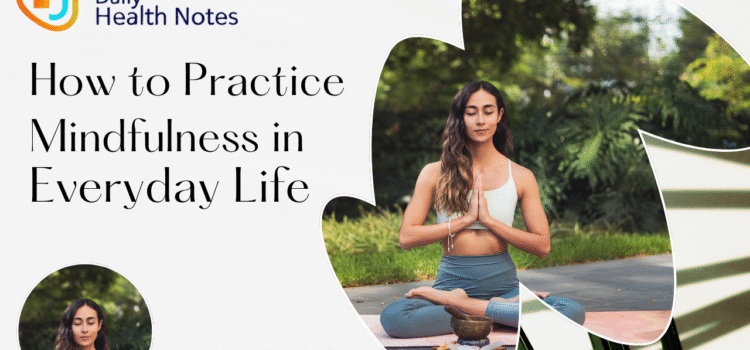
How to Practice Mindfulness in Everyday Life: A Simple Guide to Being Present
In today’s fast-paced world, it’s easy to get caught up in the hustle and bustle of daily tasks, often losing touch with the present moment. If you find yourself constantly multitasking, feeling stressed, or unable to fully enjoy life, mindfulness could be the solution you need. But how can you practice mindfulness in everyday life?
Mindfulness is the practice of staying fully present in the moment, focusing on what you’re doing without judgment or distraction. It’s a skill that can lead to greater mental clarity, reduced stress, and improved well-being. In this blog post, we’ll explore how to apply mindfulness in your daily routine, why it matters, and how you can incorporate it into everyday activities for a more fulfilling life.
What is Mindfulness?
Mindfulness is rooted in ancient Buddhist teachings, but it has been widely embraced in modern psychology and wellness practices in the United States. Simply put, mindfulness means being aware of your thoughts, feelings, and bodily sensations in the present moment without getting caught up in past regrets or future anxieties. By practicing mindfulness, you develop a sense of awareness that can help you better manage your emotions, relationships, and overall stress levels.
Benefits of Practicing Mindfulness in Everyday Life
Before diving into the “how” of mindfulness, it’s essential to understand the powerful benefits it can bring to your life. These include:
1. Reduced Stress and Anxiety
Mindfulness helps activate the parasympathetic nervous system, which calms the body’s stress response. Research from Harvard Medical School shows that mindfulness can significantly reduce anxiety and stress, making it an effective tool for coping with daily pressures.
2. Improved Focus and Concentration
Regular mindfulness practice improves your ability to stay focused and present. Studies have shown that mindfulness helps enhance cognitive abilities, such as attention and memory, by training the brain to stay engaged in the task at hand rather than getting distracted.
3. Better Emotional Regulation
Mindfulness helps you become more aware of your emotions and reactions, allowing you to respond rather than react impulsively. This leads to healthier relationships and a greater sense of emotional balance.
4. Increased Self-Awareness
By practicing mindfulness, you gain insight into your thoughts, feelings, and patterns of behavior. This heightened self-awareness can lead to personal growth and help you make more thoughtful, intentional choices in your life.
5. Physical Health Benefits
Mindfulness isn’t just good for your mind—it’s beneficial for your body, too. Studies have found that mindfulness can lower blood pressure, reduce chronic pain, and boost overall health by promoting relaxation and reducing inflammation.
How to Practice Mindfulness in Everyday Life
1. Start with the Breath
One of the simplest ways to practice mindfulness is by focusing on your breath. Whether you’re at home, at work, or running errands, take a few moments to inhale deeply and exhale slowly. This helps you center yourself and anchor your awareness in the present moment. Try this for just 2-5 minutes a day to start.
Tip: When you notice your mind wandering, gently bring your focus back to your breath without judgment.
2. Practice Mindful Eating
How often do you eat while distracted—watching TV, scrolling through your phone, or working? Mindful eating involves paying attention to each bite, noticing the texture, flavor, and aroma of your food. By eating mindfully, you’ll not only improve digestion but also enhance your relationship with food.
Tip: Try to eat without distractions. Slow down and focus on the experience of eating—chewing your food slowly, appreciating each flavor.
3. Mindful Walking
Walking is a simple yet powerful opportunity for mindfulness. Whether you’re walking in your neighborhood, at the park, or even inside your home, pay attention to the sensations in your body. Notice how your feet feel as they touch the ground, the rhythm of your stride, and the sounds around you.
Tip: Walk slowly and intentionally. If your mind begins to wander, gently guide it back to the feeling of your feet moving.
4. Mindful Listening
In conversations, we often listen to respond rather than truly hear what the other person is saying. Mindful listening means paying full attention to the speaker without planning your response. This fosters better communication and deeper connections.
Tip: Focus on the person speaking, listen actively, and avoid interrupting or formulating responses while they talk.
5. Mindfulness During Routine Activities
Everyday tasks like washing dishes, folding laundry, or brushing your teeth are perfect opportunities for practicing mindfulness. Instead of rushing through these tasks, bring your full attention to the sensations, movements, and actions involved. This transforms mundane activities into moments of mindfulness.
Tip: Engage all your senses. Notice the sound of the water, the feel of the soap, and the rhythm of the motions as you wash dishes.
6. Use Mindfulness to Manage Stress
When stress or anxiety creeps in, mindfulness can help you regain control. Rather than allowing yourself to be consumed by overwhelming thoughts, pause and take a few deep breaths. Ground yourself in the present moment, acknowledging your feelings without judgment.
Tip: Use mindfulness techniques, like the body-scan meditation, to check in with yourself. Start at your toes and work your way up, noticing any tension and releasing it as you go.
Challenges to Mindfulness and How to Overcome Them
While mindfulness offers numerous benefits, practicing it in everyday life isn’t always easy. Here are some common challenges and how to overcome them:
1. Difficulty Staying Present
It’s natural for your mind to wander. Over time, you’ll get better at refocusing your attention, but it’s important to be patient with yourself.
Solution: Start small with short, 2-3 minute mindfulness exercises and gradually increase the duration as you become more comfortable.
2. Lack of Time
Many people feel they don’t have enough time to practice mindfulness. However, mindfulness doesn’t require hours of your day. Just a few minutes of intentional focus can be highly effective.
Solution: Incorporate mindfulness into your daily routine by practicing while doing chores or during short breaks at work.
3. Impatience with Results
Mindfulness is a skill that takes time to develop, and it can be frustrating if you don’t see immediate results. Remember, it’s not about perfection but about progress.
Solution: Be consistent and compassionate with yourself. Trust that the benefits of mindfulness will unfold with time.
Expert Opinions on Mindfulness
According to Dr. Jon Kabat-Zinn, a leading mindfulness expert and the creator of the Mindfulness-Based Stress Reduction (MBSR) program, “Mindfulness is the art of being present, moment by moment, without judgment. It allows us to respond to situations with clarity, rather than react impulsively.”
The National Institutes of Health (NIH) also recognizes mindfulness as an effective practice for managing stress and improving mental health, with numerous studies backing its positive impact on conditions like depression, anxiety, and chronic pain.
Conclusion: Start Your Mindful Journey Today
Mindfulness is a simple but powerful tool that can improve every aspect of your life. By practicing mindfulness in everyday life—whether during a walk, a meal, or even a conversation—you can experience reduced stress, better focus, and enhanced emotional well-being.












